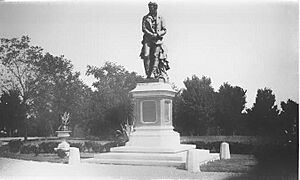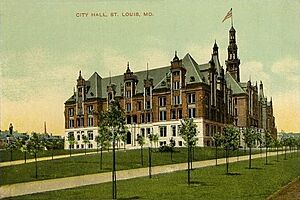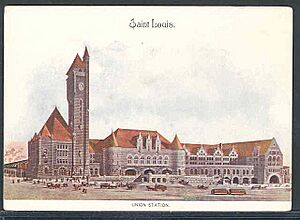History of St. Louis (1866–1904) facts for kids
The history of St. Louis, Missouri, from 1866 to 1904 was a time of fast growth. The city's population grew a lot. It became the fourth-largest city in the United States. Only New York City, Philadelphia, and Chicago were bigger. St. Louis also saw a quick rise in factories, buildings, and ways to get around. This period ended with the city hosting the 1904 World's Fair and the 1904 Summer Olympics.
Contents
Building a Better City
After the Civil War, St. Louis needed many repairs. The city's water and sewer systems were not good. Many people got sick from diseases like cholera. In 1866, a cholera outbreak killed over 3,500 people.
To fix this, the city created the St. Louis Board of Health. This group made rules to keep the city clean. They also watched over factories that caused pollution. A new water system was built in 1871. It included a large reservoir at Compton Hill. Gas lighting also got better in the 1870s. The Laclede Gaslight Company was formed to light the south side of the city.
In the early 1870s, new industries came to St. Louis. One was cotton compressing. This made raw cotton smaller for shipping. By 1880, St. Louis was the third-largest cotton market in the U.S. Most cotton arrived by railroad. The Cotton Belt Railroad started in St. Louis in 1879. It connected the city to cotton farms in Texas.
St. Louis also added more parks in the 1860s and 1870s. In 1868, Henry Shaw gave land for Tower Grove Park. In 1872, the state allowed the city to buy over 1,000 acres for a new park. This land became Forest Park, which opened in 1876. At first, some people doubted the park. But the city grew to surround it. Forest Park was once home to Native American burial mounds. When it first opened, everyone could use the park. But later, rules that separated people by race limited its use for African-Americans.
Schools: New Ideas and Challenges
After the Civil War, money for schools came from property taxes. By 1870, public schools had over 24,000 students. Private schools had over 4,000. In the 1870s, St. Louis schools followed William Torrey Harris's ideas. He focused on good behavior and learning grammar, philosophy, and math.
Harris also brought new ideas. He started the first public kindergarten in the United States. Susan Blow taught the first class in 1874. At first, some people didn't like the idea. But kindergarten became very popular in St. Louis. By the late 1870s, 7,800 students were in kindergarten.
Schools for African-American students faced many challenges. Some early schools were closed by police. A school opened in 1845 but was attacked. Later, the state made it illegal to educate free black people. Ministers like John Berry Meachum ran secret schools. Some were even on steamboats on the Mississippi River.
In 1864, a group of St. Louisans formed a board for "Colored Schools." They opened schools for over 1,500 students without public money. In 1865, Missouri's new constitution said cities must support black education. St. Louis gave a small amount of money for this. Schools for black students often had poor facilities. Teachers earned less than half of what white teachers made.
In 1875, after much effort, high school classes began at Sumner High School. It was the first high school for black students west of the Mississippi River. But differences in schools for black and white students remained.
Connecting the City: Bridges and Trains
Railroads connected St. Louis to the west. But there was a big problem: how to cross the Mississippi River to the east. From 1820 to 1865, one ferry company controlled river crossings. This caused high costs and delays, especially in winter. Plans for a bridge started in 1839 but were too expensive.
After the Civil War, bridges were built over the Mississippi in other cities. This helped Chicago connect to western markets. St. Louis leaders wanted their own bridge. In 1867, bankers and merchants formed a company to build a bridge from the Missouri side.
The main engineer for the bridge was James B. Eads. He was a self-taught engineer and a skilled diver. During the Civil War, Eads designed ironclad ships for the Union. Eads chose an arch bridge design with three spans. This was because other bridge types were not allowed or would need too many supports. His German assistants, Henry Flad and Charles Pfeifer, helped him.

Building the bridge piers began in 1867. Workers used a new method called "pneumatic caissons." This method caused a sickness called "the bends." It led to the deaths of 14 workers. In 1870, a doctor helped create a safer plan. Work on the top part of the bridge began in 1871. The upper roadway was finished in April 1874.
On May 24, 1874, many St. Louisans walked on the bridge. In June, its strength was tested with a coal wagon, a train, and even an elephant! On July 2, 1874, fourteen trains loaded with coal pulled onto each span. This proved the bridge was safe. Two days later, the bridge officially opened with a big parade. Over 200,000 people came to celebrate. The bridge cost about $9 million, including interest.
To handle more trains, a new terminal called Union Depot was built in 1875. But it wasn't big enough. In 1886, Jay Gould bought the terminal and the company that owned the Eads Bridge. In 1889, Gould formed the Terminal Railroad Association of St. Louis (TRRA). This group took over the bridge and the train station. In 1893, the TRRA bought another bridge, the Merchants Bridge.
The TRRA then planned a new, much larger train station. It would replace the old one and bring all train activity to one place. Architect Theodore Link's design was chosen in 1891. The new Union Station cost $6.5 million. It opened on September 1, 1894. More railroads met in St. Louis than in any other U.S. city. Union Station was used for passenger trains until the 1970s.
Streetcar lines also grew. In 1899, 10 separate streetcar lines joined into two. One of these, the St. Louis Transit Company, faced a big strike in 1900. This strike caused unrest, leading to 14 deaths and many injuries.
St. Louis Becomes Its Own City
When Missouri became a state in 1821, St. Louis City was part of St. Louis County. But starting in the 1850s, county voters had more power over city taxes. In 1867, the county court could collect property taxes from St. Louis City. This gave the county money but took it away from the city.
City residents wanted changes. They wanted more say in county decisions. Or they wanted the city and county to join. Or they wanted St. Louis City to become its own separate city.
Early efforts tried to get more city representation in the county. But county leaders stopped these changes. In 1873, the Democratic Party took control in Missouri. This led to a new state constitution in 1875. At the meeting to write the constitution, St. Louis leaders discussed separating the city from the county. They thought joining was too hard. Separation became the main goal.
David H. Armstrong, a respected politician, helped the St. Louis delegates agree. He then convinced the whole meeting to support the idea. The plan was to separate the city from the county to stop government problems. The new Missouri Constitution, including this plan, was approved by voters in November 1874.
The plan created a Board of Freeholders from the city and county. Their job was to make them two separate areas. In 1876, the Board decided the city would act like its own county. They set up the city's rules, including 28 wards and four-year terms for the mayor. The new city rules also made the city three times bigger. It included new parks like Forest Park and important river areas.
The Board announced its plans on July 4, 1876. If voters approved, the city would become the "County of the City of St. Louis." It would take on all county debt and buy the Old Courthouse. The county would lose tax money from city property.
On August 22, 1876, it looked like St. Louis voters rejected the plan. But there was cheating in the vote. A recount found that many "no" votes were changed from "yes" votes. Some areas had more votes than voters. In December 1876, the separation was approved.
Growing Industries
In 1880, St. Louis's main industries were brewing beer, milling flour, meat processing, making machines, and tobacco. Other industries made paint, bricks, bags, and iron. In the 1880s, the city's population grew by 29 percent. It went from about 350,000 to over 450,000 people. This made it the fourth-largest city in the country. It was also fourth in the value of its factory products. By 1890, there were over 6,148 factories.
However, factory growth slowed in the 1890s. A financial crisis in 1893 hurt many businesses. Flour milling production was cut in half. Most other industries also struggled.
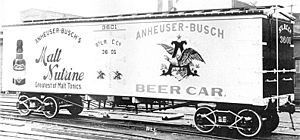
The brewing industry started in St. Louis after the Louisiana Purchase. Before the Civil War, beer was mostly made for local use. When Adam Lemp arrived in 1842, he brought lager beer. This quickly became very popular. The industry grew fast in the late 1850s. There were 24 breweries in 1854 and 40 in 1860. Brewing became the city's largest industry by 1880.
The two biggest St. Louis breweries were Anheuser-Busch and Lemp Brewery. Together, they made 1.5 million barrels of beer in 1900. St. Louis breweries were also innovators. Anheuser-Busch was the first to use refrigerated train cars to ship beer. They were also the first to sell pasteurized bottled beer.
Pollution Challenges
Fast industrial growth brought a lot of pollution to St. Louis. Brick making caused air pollution. Paint making created lead dust. Beer brewing produced waste. But the worst pollution came from coal dust and smoke. St. Louis was known for its smoky air by the 1890s. Most factories used coal for power. Homes used a type of coal that made more smoke. Trains also created thick clouds of smoke around stations.
Noise was also a problem. Many homes were mixed in with factories. Old sinkholes were filled with factory waste, sewage, and garbage.
The biggest complaints to the St. Louis Board of Health were about "rendering" factories. These factories turned dead animal parts into useful products. This process created very bad smells. People said the smells were so strong they could be smelled for miles. They were so bad they could even slow down incoming trains.
Even with these problems, courts often did not stop pollution. They wanted to help the economy grow. If a complaint was proven, factories usually just paid money instead of stopping the pollution. In 1880, a new plan tried to gather polluting industries in certain areas. The Board of Health tried to move factories to the North Riverfront and Baden neighborhoods. Other factories gathered along the Pacific Railroad line through Mill Creek Valley.
City Growth and New Homes
St. Louis is one of several cities that claims to have the world's first skyscraper. The Wainwright Building, a 10-story building designed by Louis Sullivan, was built in 1892. It still stands today and is used by the state of Missouri. Large companies like Ralston-Purina and the Brown Shoe Company were based in St. Louis.
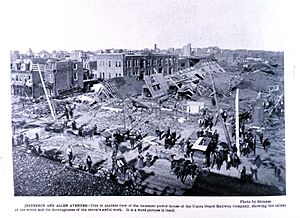
From the 1840s, the richest families in St. Louis lived on the edges of the city. In the 1850s and 1860s, many wealthy business people lived on Washington Avenue. But the Eads Bridge brought more businesses to that area. Other rich areas included Lucas Place and Lafayette Square. These were popular in the 1870s. Only the Campbell House remains from Lucas Place.
Lafayette Square stayed popular until the 1896 St. Louis-East St. Louis tornado. This storm killed over 140 people and destroyed many buildings. Some homes were rebuilt, but many residents moved away. By 1918, the area around Lafayette Square was changed for business use.
After Lafayette Square, wealthy St. Louisans moved to a private area called Vandeventer Place in the 1890s. But as streetcars expanded, nearby streets became commercial. This led the rich to move further west to the Central West End neighborhood. This area included private places like Westmoreland Place and Portland Place. The people living in these homes were a powerful group. They included St. Louis Mayor Rolla Wells and Missouri Governor David R. Francis.
The growth of these private areas in the Central West End happened at the same time as country estates grew in St. Louis County. Towns like Normandy and Florissant were connected to St. Louis by railroad starting in 1876. This allowed for large estates and social clubs. Famous writers like Sara Teasdale and T. S. Eliot lived in the city during this time.
Nikola Tesla showed his wireless lighting system in St. Louis in 1893. He lit glass tubes without wires. Tesla thought this wireless technology could also send information.
Music and Sports
Starting in the 1890s, the Chestnut Valley area became the home of St. Louis ragtime music. Saloons in Chestnut Valley hired musicians to play. W.C. Handy was one of these musicians. His song "St. Louis Blues" remembers his time there. Just west of Chestnut Valley, ragtime composer Tom Turpin ran a club. He held ragtime playing contests. Many famous ragtime artists played at Turpin's club. These included Scott Hayden and Arthur Marshall.
Ragtime composer Scott Joplin moved to St. Louis in 1901. He worked with Tom Turpin and wrote music in the city. He moved to Chicago in 1907. After 1906, some music clubs moved to an area called Deep Morgan. Blues and Boogie Woogie pianists played there. In Deep Morgan, ragtime changed into blues music. Clubs in Chestnut Valley started playing early jazz music.
Joplin's home was saved by the local African American community. In 1983, it became a state historic site. It now tells the story of Joplin, ragtime, and the history of black people moving to the city. It also talks about difficult topics like unfair treatment and poverty.
The sport of baseball began in St. Louis after the Civil War. A team called the St. Louis Brown Stockings started in 1875. They were a founding member of the National League. They beat the Chicago White Stockings in their first game. But the original Brown Stockings team closed in 1878.
A new National League team with the same name started in 1882. This team changed its name many times. It became the Browns in 1883, then the Perfectos in 1899. Finally, it became the St. Louis Cardinals in 1900.
In the 1880s, St. Louis also had another team, the St. Louis Maroons. In 1901, St. Louis became a two-team city again. An American League team, the St. Louis Browns, joined. The Browns were more popular than the Cardinals in the 1910s and 1920s. But neither team won a championship until after 1925.
Challenges and Unrest
In 1871, a man named John McDonald came to St. Louis. He was in charge of collecting liquor taxes. He started a large plan to hide how much whiskey was made. The extra money was used to help political campaigns. This plan, called the Whiskey Ring, spread to other cities. It involved many government officials.
In 1874, a new Treasury Secretary started an investigation. In the end, 32 distilleries were seized. Millions of dollars in taxes were recovered. Many people were charged. One person involved was Orville Babcock, President Grant's personal secretary. When Babcock was found not guilty, it hurt the image of the Republican party.
St. Louis hosted the Democratic National Convention in June 1876. Because of the problems with the Republican party, the Democrats chose Samuel Tilden for President. This led to a very close election in 1876.
People were also frustrated with government problems. Many railroad companies went bankrupt and cut workers' pay. After the third pay cut by the B&O railroad, workers in West Virginia went on strike. This led to the Great Upheaval. Railroad workers across the country went on strike. They wanted better working conditions. In some cities, like St. Louis, the strike grew into a general strike. Workers from many industries demanded things like an eight-hour workday and an end to child labor.
The 1904 World's Fair
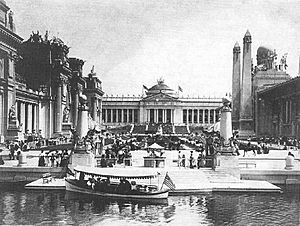
Since the 1850s, St. Louis had hosted yearly fairs at Fairground Park. These fairs connected with local farmers and factories. But by the 1880s, the focus shifted from farming. In 1883, a new hall was built for factory exhibits. In 1890, St. Louis tried to host the World's Fair. But Chicago was chosen instead.
In 1899, leaders from states that were part of the Louisiana Purchase met in St. Louis. They chose St. Louis to host a world's fair celebrating 100 years since the purchase. By the end of 1900, St. Louisans had bought over $5 million in fair company stock. The city gave another $5 million. The U.S. Congress also gave $5 million.
The fair directors chose the western part of Forest Park for the fair. This caused a building boom in the area. Many hotels were built downtown and in the Central West End. Temporary places to stay were also built at the fairgrounds.
As the fair was built, it became clear that Forest Park wasn't big enough. So, the fair leased land from Washington University in St. Louis. The total fairgrounds covered 1,272 acres. Streetcar and train service to the area improved. A new water filter system was also put in place. Other improvements included a wooden bridge and better paved streets. These helped reduce dust in the air.
The fair itself was like an "Ivory City" with twelve temporary buildings. One permanent building became the St. Louis Art Museum after the fair. The fair celebrated American growth and world cultures. It had exhibits on French fur trading and villages of people from other parts of the world. At the same time, the 1904 Summer Olympics were held in St. Louis. They took place at what is now the campus of Washington University.


